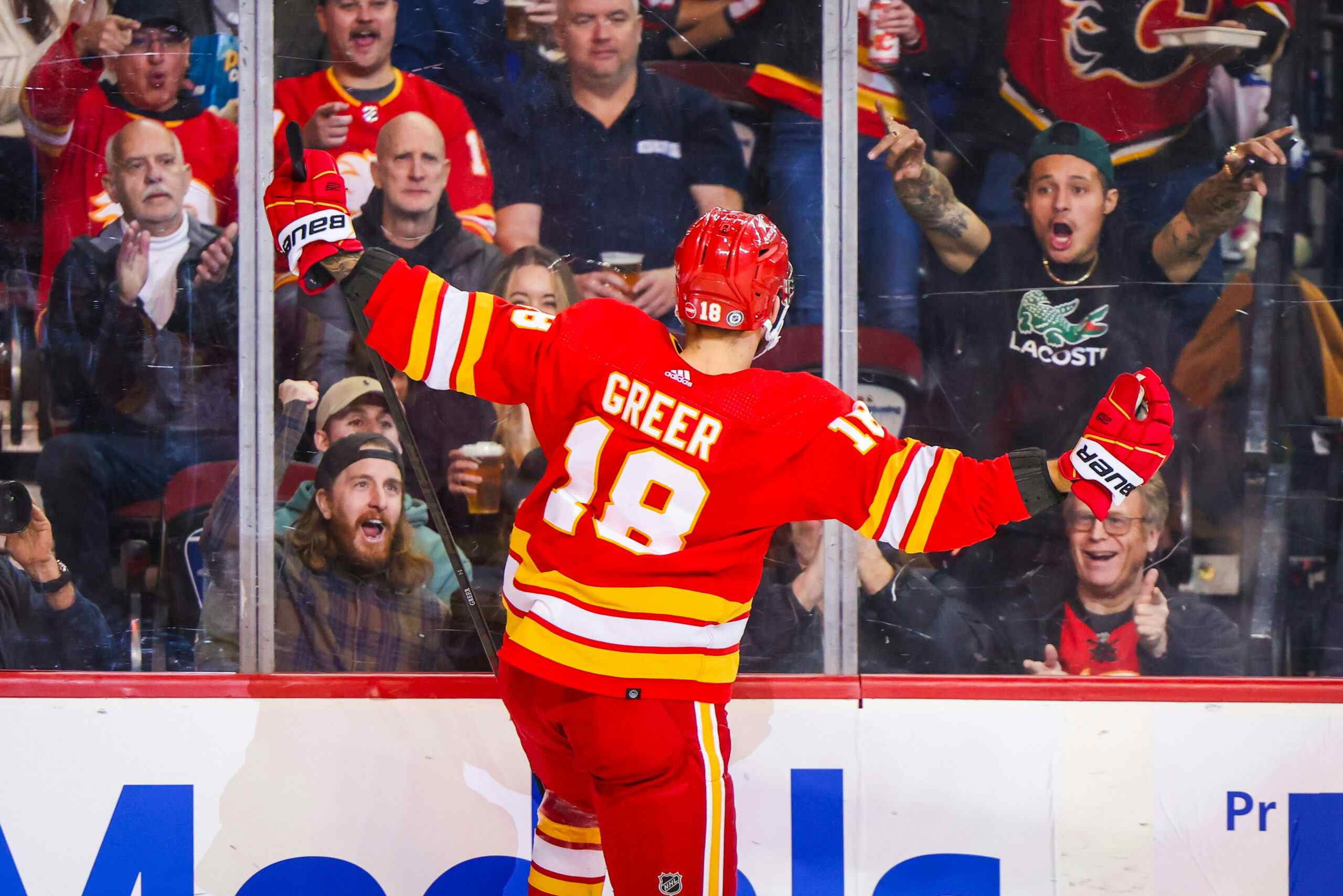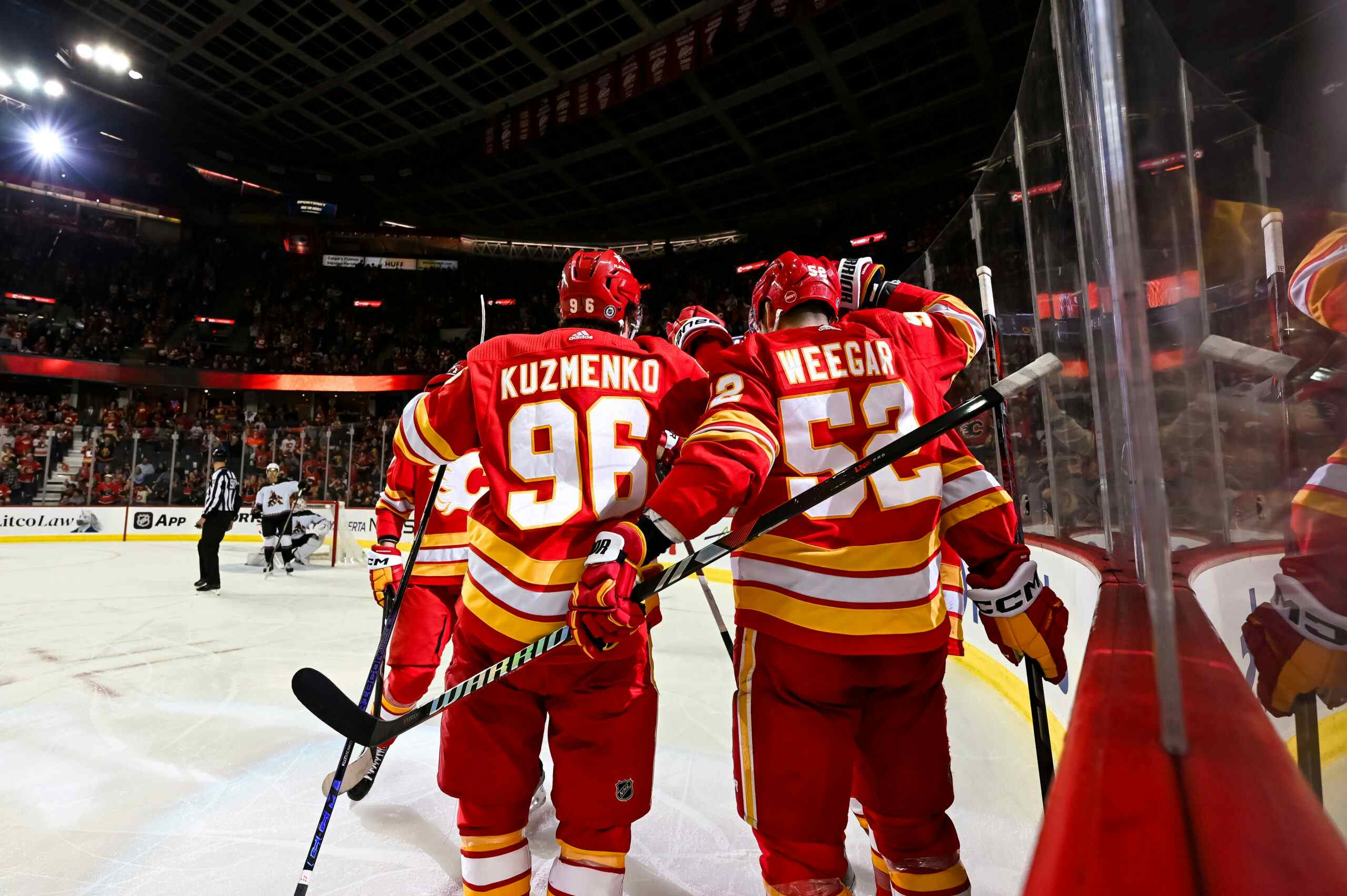Flames 4, Oilers 2 post-game embers: Battling the comeback

By Mike Pfeil
5 years agoOn Friday morning, Ari wrote, “The Flames can’t keep fighting Mike Smith in addition to another NHL team and expect to win,” and she was right. This time the Flames decided to fight another NHL team; themselves; and then, in the hour of twilight, they put it all together again, and came out with a win.
Feel of the game
Well, it was the Battle of Alberta, so Saturday morning in the time-old (12-year) tradition I woke up my neighbours here in Edmonton by screaming “Go Flames go” at the top of my lungs. After a brief, but heated conversation, and threats of calling the police I then set fire to my roommate’s Leon Draisaitl jersey in our fireplace. He knew what he signed up for when he moved in.
Saturday night was everything that we’ll tell our grandchildren and descendants about when it comes to the Battle of Alberta. It’s not just that it channeled the dated pugilism, theatrics, and antics of the 80s, but it encompassed the state of the game in 2018. The Flames, typically, relied on a third period comeback. The Oilers, typically, played Milan Lucic alongside Connor McDavid.
It’s not surprising, but it is all at once. This was, in its very nature, perfection: the (what appears to be) unstoppable force of third period comebacks from the Calgary Flames meeting the stopping force of Lucic anchoring down the league’s most talented player. Summing the game up in that sense is a perfect way of explaining this clash of rivals who briefly lapsed into a coma somewhere in the last three days.
Still, while impressive, the comebacks are quickly approaching a point of concern. Lionizing the goals in the third takes on a whole new meaning when you objectively look at the Flames’ play in first and second periods. It’s something that isn’t as cut and dry as it comes off on broadcasts. It’s a nuanced issue that needs to be dissected objectively.
The good news
The secondary power play unit scored a goal. This alone should prompt a parade through Calgary, and not one of those hypothetical “Stanley Cup parades” that every city plans. This should be one that the entire city, the entire fanbase, and surrounding area attends. The fact that it happened and we witnessed it, it should be regarded as a Canadian Heritage Moment.
Maybe the leftover Olympic bid money can be used to build a statue of Derek Ryan commemorating this goal.
Let’s talk about Matthew Tkachuk now. With the penalties drawn last night, Tkachuk has drawn an impressive 104 penalties since 2016-17. At 5v5, he’s drawn two more than McDavid with 75. That’s 75 opportunities for the Flames to capitalize by scoring first, drawing even, or getting back into a game. In a game where he didn’t register a single point, and only had one shot on net and two total shot attempts, he made his presence felt.
You can hate him, which was on full display in the Oilers community last night. You can love him, which the Flames community has fully embraced since day one. What connects both sides of the conversation is the fact that he is effective at what he does and it was on full display. Thirty other teams, including Edmonton, probably wish they had him. One team right now – and hopefully for the extended future – has him.
His emergence early on this season showing off the growth of his offensive skills at the NHL has impressed many, but it’s the continued growth in his shit-disturbing skills that is easily the most captivating facet of his game.
The bad news
Let’s circle back on the third period comebacks, and how they aren’t sustainable. Remember the 2014-15 Flames, with their third period goal differential of +31? That didn’t carry over to 2015-16, when their third period goal differential plummeted to -23.
Specifically to this season, the Flames have played 945:52 minutes at 5v5, according to Natural Stat Trick. Nearly half of that time – 468:07 minutes, to be exact, which is roughly 49% of their total 5v5 time – they have trailed in the game (321:58 has been when they’re down by one: about 69% of their total time trailing). Their 5v5 CF is 54.92%, but when they’re trailing it jumps up to 60.99% (60.00% when down by one).
Fact of the matter is, spending half your time trailing is bad, and there’s a noticeable difference in the Flames’ numbers and performance when they’re losing. They’re probably still a good team, but their first and second periods need to be a lot better.
The woes on the power play – outside of the Ryan goal – continue and it begs the question (again, because it continues to be a problem) of whether or not Geoff Ward’s changes are helping. When PP1 doesn’t do much and the lone long-awaited goal from PP2 occurs, you start to see the increasing woes on aggregate.
One thing the Flames could do is change up their power play units, specifically by putting James Neal on the top unit, where he could shoot to his heart’s content. The corresponding move would be to put Tkachuk on the second unit for a bit, as well as one of Rasmus Andersson or Juuso Valimaki, either replacing Noah Hanifin or alongside him in a 3F2D configuration. Even though he scored, Ryan isn’t a long-term solution for the power play.
After Saturday’s game the Flames have the 20th ranked power play in the NHL with a success rate of 18.3%. They went one-for-six against the Oilers.
Numbers of note
- Three shorthanded breakaways… against.
- 14 games without a goal for Ryan, who scored the secondary power play unit’s rare (and only) goal. Ryan’s family treated him to a post-game slice of Wonderbread and water on the side for dippin’.
- 32 third period goals – eat your heart out, 2014-15 Calgary Flames.
- Five shots against in the third period – none of which came from noted best player in the NHL Connor McDavid. His last shot on net? 18:39 into the second period, during the Oilers’ power play that closed out the frame. The Flames found a way to neutralize him, which is great, because finding ways to suppress him for any interval of time is valuable.
- 10:30 into the third period, the Oilers got their second shot on net of the third.
- 6:56 between the first Oilers shot of the third and their second.
- 92.86% and 92.31% – the CFs of Sean Monahan when with Noah Hanifin and Travis Hamonic. As Hanifin has had some struggles this season with some gaffes, the emergence and chemistry of Hanifin and Hamonic has been incredible. For the most part the Flames are rolling three full defensive pairings of capable skill in the form of modern NHL defensemen, and it’s huge. In 12 GP this season, the pairing together sports a 62.76% CF. If Hanifin can continue to grow and round out a bit more, coupled with Hamonic’s bounce-back performance this season, then the Flames should keep this pairing together for as long as possible.
- Three! Three penalties drawn by the pest known as Matthew Tkachuk. We talked about this already, but it’s worth drawing attention to here.
- .933% – David Rittich’s SV% on the season is continued proof that it’s worth seeing more from him over Smith. It’s a tired topic, as it’s been discussed ad nauseam, but it should be evident by now to all parties that this is the best option. Paraphrasing then coach/general manager Darryl Sutter in 2004: “It’s not about Saturday night. It’s about going forward.” This isn’t a declaration that Rittich will become this team’s Miikka Kiprusoff, but a plea to run with the man named Big Save Dave in net.
- Two more for Elias Viktor Zebulon Lindholm gives him 11 goals in 20 games. It’s extremely unlikely that he’ll continue at 21.6% SH% over the course of the season. Still, the concern of whether or not he could unlock more of an offensive game has been settled already. It’s just a matter of seeing how much variance through the next 62 games appears and if he can set new career highs playing on that top line/top PP unit.
Final thought
The next Battle of Alberta is on Dec. 9. Between Nov. 18 and then, the Flames have to take the next logical step in their season by building upon legitimate consistency. I know that this fanbase may be sick of the obsession in consistency, but it’s a prerequisite for this spring when the team is in a playoff spot or hunting for one.
Their assorted schedule, including games against the Winnipeg Jets on Nov. 21, a matinee game on Nov. 25 against the lethal shorthanded goal-scoring Arizona Coyotes, and a brief foray into the top teams in the Central (Dec. 6 versus Minnesota, Dec. 8 versus Nashville) are all examples of opportunities for the team.
They might not win all of the next 10 games, but if they can string together cohesive play in first or second periods by that time they may be poised for a better showing against their most dreaded rivals. Be it scoring from Neal, or more offensive output as a whole from the bottom six of the roster, or even a shred of better play out of Smith, it will be a boon as they head into the mid-season doldrums that often occur.
Recent articles from Mike Pfeil





